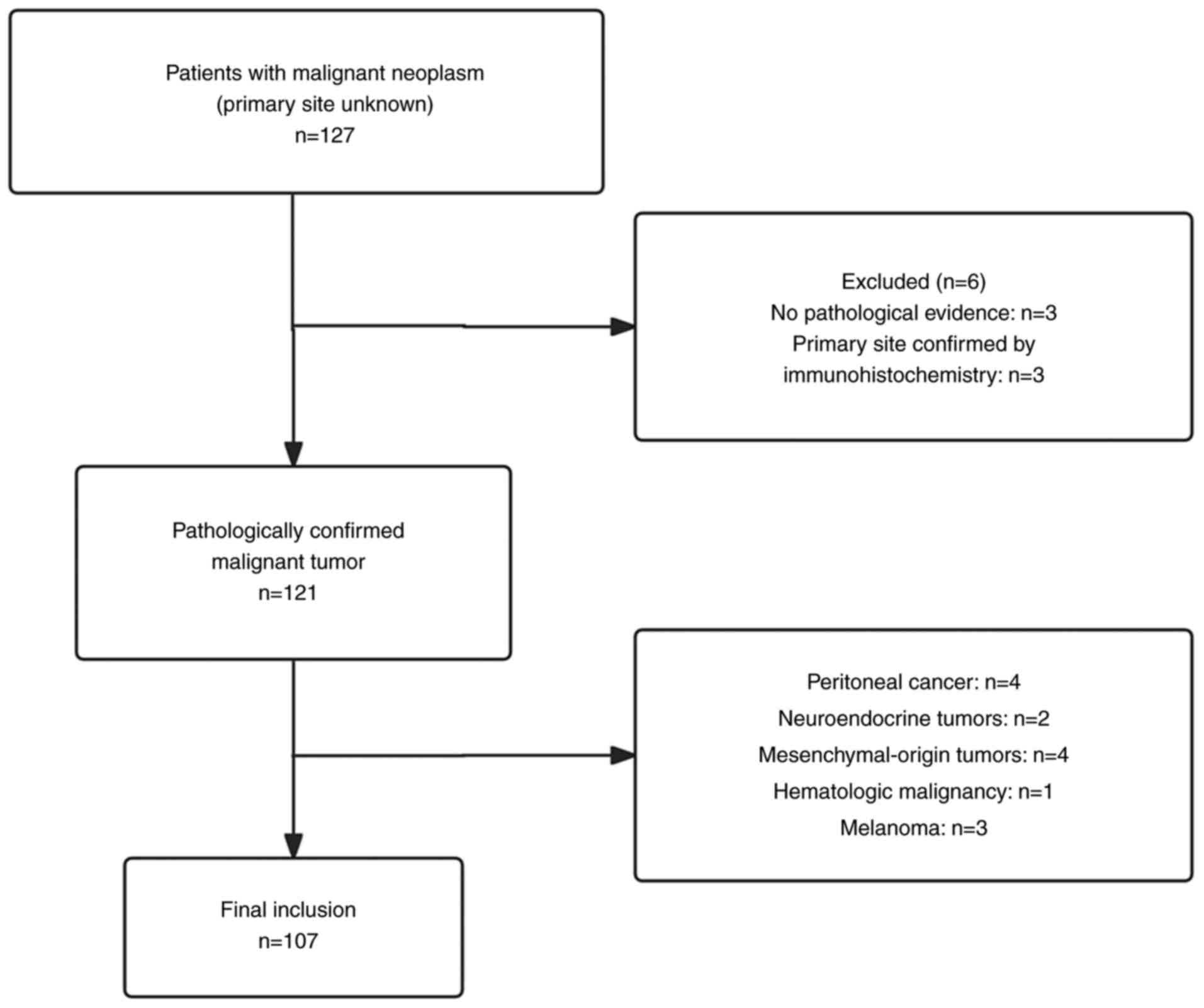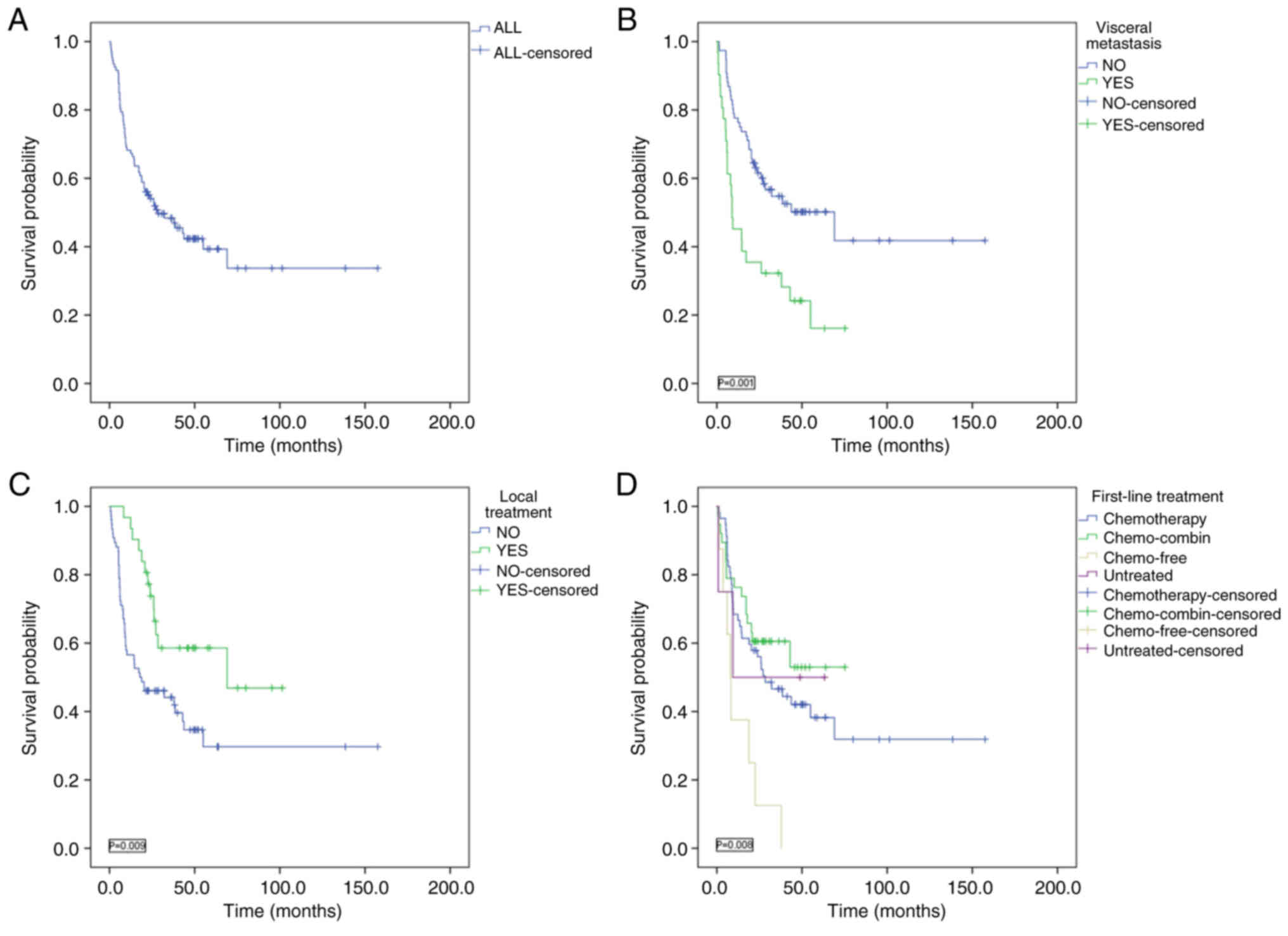|
1
|
Levi F, Te VC, Erler G, Randimbison L and
La Vecchia C: Epidemiology of unknown primary tumours. Eur J
Cancer. 38:1810–1812. 2002. View Article : Google Scholar : PubMed/NCBI
|
|
2
|
Lee MS and Sanoff HK: Cancer of unknown
primary. BMJ. 371:m40502020. View Article : Google Scholar : PubMed/NCBI
|
|
3
|
Pavlidis N, Briasoulis E, Hainsworth J and
Greco FA: Diagnostic and therapeutic management of cancer of an
unknown primary. Eur J Cancer. 39:1990–2005. 2003. View Article : Google Scholar : PubMed/NCBI
|
|
4
|
Pavlidis N and Fizazi K: Carcinoma of
unknown primary (CUP). Crit Rev Oncol Hematol. 69:271–278. 2009.
View Article : Google Scholar : PubMed/NCBI
|
|
5
|
Brustugun OT and Helland A: Rapid
reduction in the incidence of cancer of unknown primary. A
population-based study. Acta Oncol. 53:134–137. 2014. View Article : Google Scholar : PubMed/NCBI
|
|
6
|
Boo YK, Park D, Lim J, Lim HS and Won YJ:
Descriptive epidemiology of cancer of unknown primary in South
Korea, 1999–2017. Cancer Epidemiol. 74:1020002021. View Article : Google Scholar : PubMed/NCBI
|
|
7
|
Rassy E and Pavlidis N: The currently
declining incidence of cancer of unknown primary. Cancer Epidemiol.
61:139–141. 2019. View Article : Google Scholar : PubMed/NCBI
|
|
8
|
Ren M, Cai X, Jia L, Bai Q, Zhu X, Hu X,
Wang Q, Luo Z and Zhou X: Comprehensive analysis of cancer of
unknown primary and recommendation of a histological and
immunohistochemical diagnostic strategy from China. BMC Cancer.
23:11752023. View Article : Google Scholar : PubMed/NCBI
|
|
9
|
Sunami K, Takahashi H, Tsuchihara K,
Takeda M, Suzuki T, Naito Y, Sakai K, Dosaka-Akita H, Ishioka C,
Kodera Y, et al: Clinical practice guidance for next-generation
sequencing in cancer diagnosis and treatment (Edition 1.0). Cancer
Sci. 109:2980–2985. 2018. View Article : Google Scholar : PubMed/NCBI
|
|
10
|
Thai AA, Solomon BJ, Sequist LV, Gainor JF
and Heist RS: Lung cancer. Lancet. 398:535–554. 2021. View Article : Google Scholar : PubMed/NCBI
|
|
11
|
Erlander MG, Ma XJ, Kesty NC, Bao L,
Salunga R and Schnabel CA: Performance and clinical evaluation of
the 92-gene real-time PCR assay for tumor classification. J Mol
Diagn. 13:493–503. 2011. View Article : Google Scholar : PubMed/NCBI
|
|
12
|
Fizazi K, Greco FA, Pavlidis N and
Pentheroudakis G; ESMO Guidelines Working Group, : Cancers of
unknown primary site: ESMO Clinical Practice Guidelines for
diagnosis, treatment and follow-up. Ann Oncol. 26 Suppl
5:vi33–vi38. 2011.
|
|
13
|
Greco FA, Spigel DR, Yardley DA, Erlander
MG, Ma XJ and Hainsworth JD: Molecular profiling in unknown primary
cancer: Accuracy of tissue of origin prediction. Oncologist.
15:500–506. 2010. View Article : Google Scholar : PubMed/NCBI
|
|
14
|
Li Z, Li F, Pan C, He Z, Pan X, Zhu Q, Wu
W and Chen L: Tumor cell proliferation (Ki-67) expression and its
prognostic significance in histological subtypes of lung
adenocarcinoma. Lung Cancer. 154:69–75. 2021. View Article : Google Scholar : PubMed/NCBI
|
|
15
|
Sun X and Kaufman PD: Ki-67: More than a
proliferation marker. Chromosoma. 127:175–186. 2018. View Article : Google Scholar : PubMed/NCBI
|
|
16
|
Wei B, Kang J, Kibukawa M, Arreaza G,
Maguire M, Chen L, Qiu P, Lang L, Aurora-Garg D, Cristescu R and
Levitan D: Evaluation of the trusight oncology 500 assay for
routine clinical testing of tumor mutational burden and clinical
utility for predicting response to pembrolizumab. J Mol Diagn.
24:600–608. 2022. View Article : Google Scholar : PubMed/NCBI
|
|
17
|
Society of Cancer of Multiple and Unknown
Primary of China Anti-Cancer Association, . China Anti-Cancer
Association guideline for diagnosis and treatment of cancer of
multiple and unknown primaries (2023 edition). Chin Oncol.
33:403–422. 2023.
|
|
18
|
Greco FA, Lennington WJ, Spigel DR and
Hainsworth JD: Molecular profiling diagnosis in unknown primary
cancer: Accuracy and ability to complement standard pathology. J
Natl Cancer Inst. 105:782–790. 2013. View Article : Google Scholar : PubMed/NCBI
|
|
19
|
Weiss LM, Chu P, Schroeder BE, Singh V,
Zhang Y, Erlander MG and Schnabel CA: Blinded comparator study of
immunohistochemical analysis versus a 92-gene cancer classifier in
the diagnosis of the primary site in metastatic tumors. J Mol
Diagn. 15:263–269. 2013. View Article : Google Scholar : PubMed/NCBI
|
|
20
|
Morawietz L, Floore A, Stork-Sloots L,
Folprecht G, Buettner R, Rieger A, Dietel M and Huebner G:
Comparison of histopathological and gene expression-based typing of
cancer of unknown primary. Virchows Arch. 456:23–29. 2010.
View Article : Google Scholar : PubMed/NCBI
|
|
21
|
Meiri E, Mueller WC, Rosenwald S, Zepeniuk
M, Klinke E, Edmonston TB, Werner M, Lass U, Barshack I, Feinmesser
M, et al: A second-generation microRNA-based assay for diagnosing
tumor tissue origin. Oncologist. 17:801–812. 2012. View Article : Google Scholar : PubMed/NCBI
|
|
22
|
Rassy E and Pavlidis N: Progress in
refining the clinical management of cancer of unknown primary in
the molecular era. Nat Rev Clin Oncol. 17:541–554. 2020. View Article : Google Scholar : PubMed/NCBI
|
|
23
|
Meijer L, Verhoeven RHA, de Hingh IHJT,
van de Wouw AJ, van Laarhoven HWM, Lemmens VEPP and Loef C:
Extensive diagnostic work-up for patients with carcinoma of unknown
primary. Clin Exp Metastasis. 38:231–238. 2021. View Article : Google Scholar : PubMed/NCBI
|
|
24
|
Beauchamp K, Moran B, O'Brien T, Brennan
D, Crown J, Sheahan K and Cotter MB: Carcinoma of unknown primary
(CUP): An update for histopathologists. Cancer Metastasis Rev.
42:1189–1200. 2023. View Article : Google Scholar : PubMed/NCBI
|
|
25
|
Joerger AC, Stiewe T and Soussi T: TP53:
The unluckiest of genes? Cell Death Differ. Oct 23–2024.(Epub ahead
of print). PubMed/NCBI
|
|
26
|
Bochtler T, Reiling A, Endris V, Hielscher
T, Volckmar AL, Neumann O, Kirchner M, Budczies J, Heukamp LC,
Leichsenring J, et al: Integrated clinicomolecular characterization
identifies RAS activation and CDKN2A deletion as independent
adverse prognostic factors in cancer of unknown primary. Int J
Cancer. 146:3053–3064. 2020. View Article : Google Scholar : PubMed/NCBI
|
|
27
|
Gerard L, Garcia J, Gauthier A, Lopez J,
Durand A, Hervieu V, Lemelin A, Chardon L, Landel V, Gibert B, et
al: ctDNA in neuroendocrine carcinoma of gastroenteropancreatic
origin or of unknown primary: The CIRCAN-NEC pilot study.
Neuroendocrinology. 111:951–964. 2021. View Article : Google Scholar : PubMed/NCBI
|
|
28
|
Bytnar JA, Lin J, Moncur JT, Shriver CD
and Zhu K: Cancers of unknown primary: Survival by histologic type,
demographic features, and treatment in the U.S. Military Health
System. Cancer Epidemiol. 82:1023162023. View Article : Google Scholar : PubMed/NCBI
|












